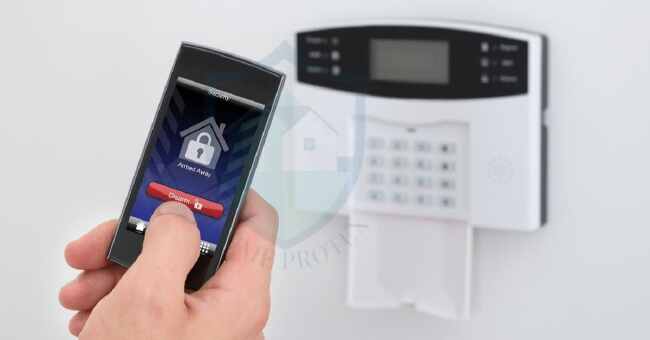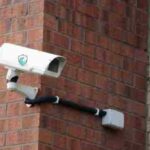Do you wish to know how to deactivate an alarm system? Yes, as homeowners’ I knew that having an alarm system in your home or business can provide an extra level of security and peace of mind.
But there are many reasons you may need to temporarily deactivate your security system, whether you’re having work done on the property, guests staying over, or even moving out permanently.
As for me, it happened when planning my daughter’s 16 years birthday party at our vacation home a few months ago, I realized I needed to temporarily deactivate the newly installed alarm system.
Having a background in electrical work, I figured it would be straightforward.
However, I ran into challenges when I couldn’t recall the passcode and mistakenly cut power to the entire home.
So learning how to properly turn off your alarm system is crucial to avoiding false alarms and unnecessary costs.
In this guide, we’ll walk through the steps to safely and completely deactivate your security system using the control panel, wireless keypad or fob, a mobile app, or through your monitoring company.
Overview On How To Deactivate An alarm System
Before disabling your security system, realize it turns off all detection and alarms. Sensors won’t monitor for intrusions or send alerts.
Doors and motion detectors won’t trigger sirens or warnings if opened. Keypads will show inactive status.
Professional monitoring will also halt. Importantly, no settings or codes are erased – the system is just temporarily dormant.
This allows flexible use of your property without false alarms.
Just be diligent about reactivating the system when leaving or sleeping to stay fully protected against intruders.
Deactivating is for short-term flexibility, not a complete shut down.
Now let’s go through the various reasons and methods to turn your alarm system off.
Reasons to Deactivate an Alarm System
While home and business security systems provide essential protection against intrusions and property crime, there are valid reasons you may need to temporarily shut down your alarm monitoring functions.
Understanding the most common scenarios when deactivating your systems can prevent false alarms and unnecessary monitoring fees.
These are the reasons to deactivate an alarm system:
- Scheduled Maintenance or Cleaning
- House Guests Staying Over
- Moving Out of a Property
- Upgrading Security Systems
Scheduled Maintenance or Cleaning
One of the most common reasons to disable a security alarm system is to accommodate maintenance visits, contractors, house cleaners, and other scheduled service calls.
Things like HVAC filter changes, carpet cleanings, pest control visits, and landscaping crews often require freedom of movement without setting off interior motion detectors.
Turning off your alarm avoids costly false alarms from service visits. Just be sure to reactivate it once they are finished.
House Guests Staying Over
When guests come to stay at your home, whether for a night or a week, you’ll want to disable your security system to allow them to come and go freely without triggering alarms every time.
While it reduces security temporarily, it’s often needed for visitation unless you want to share codes and train guests on using your keypads. Be sure to turn it back on between guests.
Moving Out of a Property
When it comes time to move out of a home or business with an active alarm system, you’ll need to shut it down completely prior to your moving date.
This prevents the headaches of the new owner setting off alarms accidentally before they can install their own security equipment.
Just be sure to have the alarm company fully decommission the old system so it can’t be activated after you leave.
Upgrading Security Systems
Finally, swapping out an old alarm system for a new upgraded one requires deactivating the original equipment before uninstalling it.
Your security provider will disable the old alarm panel, keypads, and sensors so they don’t interfere with the new system installation.
Just leave them turned off until the new components are tested and activated.
While leaving your home security system active provides the best protection, there are times when temporarily disabling it makes your life easier.
Just follow proper procedures to turn off monitoring functions and be sure to reactivate it as soon as possible. Your safety should always come first.
Preparation Before Disabling Your Alarm
Before you hastily punch in your code and disable the alarm, take a few moments to prepare so the process goes smoothly.
These preparation tips will help ensure you deactivate fully and avoid any costly mistakes:
- Locate the main alarm panel – This is usually mounted on a wall near an entry door. It could be in a basement, utility closet, master bedroom, etc. Know where to access it.
- Have your unique alarm code ready – Most systems require entering a 4-6 digit numerical code to disable. Make sure you have the correct code for the current day/time ready.
- Notify your monitoring company – If your system is professionally monitored, call the monitoring company first and provide proper account details so they know you intend to disable it.
- Disable phone communications – Temporarily disable any cellular backup communicators that may still attempt to dial out alarm events even if disarmed locally.
- Gather keys or fobs – If you use wireless keypads or key fob controls, have them readily available to enter codes.
- Check for false alarms – Inspect your system for any conditions like loose contacts that may falsely trigger an alarm when disarmed.
Taking a few minutes to gather information and prepare your system for deactivation can prevent many headaches.
How to Deactivate Your Alarm System
With some preparation completed, it’s time to actually turn off your alarm system.
The specific steps to disable your security system will vary slightly based on the type of equipment.
But the general process follows the same order: enter your code, press the disable or off button, and listen for confirmation.
Here are the detailed steps to follow for different system types:
- Using the Main Alarm Panel
- Using a Wireless Keypad or Fob
- Via a Smartphone App
- Through Professional Monitoring Company
1. Using the Main Alarm Panel
For most hardwired security systems, the main alarm panel with digital keypad is the primary interface used to arm and disarm the system.
Follow these steps:
- Go to the main alarm panel, typically mounted near an entry door.
- Enter your unique 4-6 digit alarm code into the keypad. This tells the system you are an authorized user.
- Press the “Off” or “Disable” button on the panel after entering your code. This initiates the deactivation sequence.
- Listen for confirmation beeps and watch indicator lights turn off. This signals the system is now inactive.
- The panel readout should say something like “System Off” as well.
Once these steps are followed, your main security system should be fully deactivated and ready for scheduled work or visitors without alarms.
2. Using a Wireless Keypad or Fob
Many modern alarm systems can also be controlled wirelessly using portable keypads or small fob remotes.
The process is very similar:
- Locate the wireless keypad, usually placed near a secondary entry door.
- Enter your 4-6 digit alarm code into the keypad.
- Press the “Off” or “Disarm” key or button.
- Listen for beeps from the keypad to confirm deactivation.
- The keypad screen should switch to a “Disarmed Ready” or similar message.
Key fobs and panic pendants work similarly by pressing designated alarm off buttons after being prompted or inputting a security code.
This sends the wireless disable signal.
3. Via a Smartphone App
If your alarm system is professionally monitored, you likely have access to a corresponding smartphone app provided by the monitoring company.
This allows you another convenient way to control your system remotely.
- Open the app on your smartphone and log in.
- Navigate to the page indicating your system’s active status. Look for an “Armed” or similar indicator.
- Choose the option to disarm, turn off, or deactivate the system. The phrasing varies by app.
- Confirm the system status changes to “Disarmed” or another confirmation message indicating the system is inactive.
- You may also hear announcement tones from the alarm panel itself confirming the change.
Using the accompanying mobile app is an easy way to disable your system from anywhere without being physically present.
Just be sure your WiFi or cellular connection is active.
4. Through Professional Monitoring Company
If your alarm system is professionally monitored by a dedicated security company, you can also call them to deactivate your system remotely.
- Call the monitoring company’s toll-free number any time of day. This is usually printed on window decals or your alarm permits.
- Provide your name, address, account number, and any other requested identifying details so they can pull up your system.
- Specifically request to have the system disabled or put into standby mode. Some companies may require a verbal security passphrase for verification.
- The monitoring operator will send a signal to your alarm panel to deactivate it remotely.
- Wait 15-30 minutes and confirm your system shows inactive locally.
Calling your monitoring company to disable your system allows quick control without physical or app access to your property.
But keep in mind you will need to call again to reactivate it later.
What to Expect After Disabling Your Alarm
Once you’ve gone through the proper steps to turn off your home or business security system using one of the methods above, here’s what to expect:
- No audible alarms will sound – Any security sensors that are tripped will remain silent without the siren sounding.
- No visual strobe lights activated – Outdoor strobe lights that indicate an alarm also stay inactive.
- Doors and windows can open freely – Without triggering any alerts.
- Motion sensors are dormant – Movement inside will not trigger alarm events.
- No alarm notifications sent – You won’t receive push alerts on your phone or messages about sensor activity.
- Keypads show status as “disarmed” – Wireless keypads and alarm panels will display disarmed, inactive, or system off messages.
- Normal exit and entry delays deactivated – Normal grace periods for entering codes are disabled.
- Monitoring company notes status change – If professionally monitored, the monitoring center lists your system as out of service.
While your alarm system is disabled, you can essentially access and use your property normally without alarm activations.
Just be mindful that you lose security protection during this time.
How to Reactivate Your Alarm System
When you’re ready to turn your security protection back on, reactivating your system properly is important. Here’s how to bring your alarm out of dormancy:
- Return to the main alarm panel and wireless keypads.
- Enter your normal security code again.
- Press buttons like “On”, “Away”, “Arm”, or “Stay” instead of disarm.
- The panel and keypads will confirm audibly and visually that your system is active again.
- Follow your normal arming routine according to whether you’re home, away, overnight, etc.
- If professionally monitored, call to advise monitoring is being restored.
- Test your alarm by triggering sensors – confirm sirens and notifications function.
Taking a few moments to completely reactivate sensors, alarms, notifications, and professional monitoring gives you complete protection again.
When to Call a Security Professional
While the basics of deactivating and reactivating your home security system are relatively straightforward for most homeowners and business owners, there are some cases where it’s wise to call a professional:
- If you don’t have your unique alarm code – Whether you forgot it or never had it, you’ll need help bypassing the system.
- When unsure about proper steps – If you are unfamiliar with the equipment or processes, it’s safer to have an expert assist.
- To fully deactivate old system when upgrading – Professionals can disable outdated equipment as they install upgraded systems.
- For malfunctioning equipment or errors – If keypads or panels show error messages or fail to respond, call a technician.
- For permanent disabling before moving – When moving out, have a pro decommission the system so alarms aren’t left active.
While fees may apply for professional service calls, it can bring peace of mind knowing your system was properly deactivated and reactivated.
Frequently Asked Questions About Disarming Alarm Systems
How Do You Disarm An Alarm System?
The most common way to disarm a home or business alarm system is to go to the main alarm panel (usually near an entry door), enter your 4-6 digit security code, and press the “Off” or “Disarm” button.
This turns off the system’s monitoring functions so you can move freely indoors without triggering alarms.
Listen for confirmation beeps and watch for panel lights indicating the system is inactive.
How Do I Turn My House Alarm Off Without The Code?
If you don’t have your correct alarm code, you unfortunately cannot disarm most systems manually.
However, many systems can be remotely deactivated by calling the security company’s monitoring center if professionally monitored.
They can send a wireless signal disabling the alarm if you provide proper account identification.
Some advanced systems also allow disabling via smartphone app without entering a code.
But the code is generally required at the keypad to turn it off locally.
How Do I Disarm My Home Secure Alarm?
Each Home Secure alarm panel has a numeric keypad requiring a unique 4-digit master code to disarm the system.
First enter your master code, then press the “Off” button on the panel. Listen for 3 beeps and watch for the green “System Disarmed” light to confirm it is now inactive.
Remember to re-arm the panel when leaving the home. Keep your master code private and provide separate user codes for others.
Can You Disarm Alarm Without Remote?
Unfortunately most alarm systems cannot be disarmed without some type of keypad or control panel access, either directly on-site or remotely via a wireless key fob or app.
Even if you disable power, many systems have battery backups that maintain operation.
Cutting communication lines won’t work either. Safest bet is using your wall-mounted keypad or remote key fob to enter your code and turn the system off properly. There are very few workarounds.
Will Cutting Power Disable Alarm?
Professionally installed alarm systems have battery backups specifically to maintain operation during power failures.
So cutting electricity to the property, for example by flipping the main breaker, will not disable most modern security systems.
They can run on backup battery power from 8-24 hours typically. The only way to ensure the alarm is off is using your code at the keypad to fully disarm monitoring functions, not just cutting the power source. Power should be left on.
How Do You Arm And Disarm An Alarm System?
“Arming” refers to turning on an alarm system’s active monitoring functions, while “disarming” means turning them off.
Both involve using your 4-6 digit security code at the main panel or wireless keypad. To disarm, enter code + press “Off” or “Disarm” buttons. To arm, enter code again + press “On”, “Stay”, “Away” or “Sleep” buttons depending on whether you’re home, away, or overnight.
Get familiar with your panel to confidently arm when leaving, and disarm upon returning home without issue.
How Do You Turn Off A Hard Wired Alarm?
Hardwired alarm systems have a main control panel, usually in a utility room or basement, that you’ll access to disarm the system.
Enter your master alarm code into the panel keypad, then press the “Disarm”, “Off” or similar button to disable monitoring.
The panel will emit confirmation beeps and show a “System Disarmed” or equivalent message when it’s fully deactivated.
Remember to turn it back on when leaving the property. If unsure, consult your alarm system manual or call your security company.
Conclusion
Having the ability to seamlessly deactivate your home or business security system opens up greater flexibility in how you can use your property without nuisance alarms.
Just remember the core process – enter your code, press the off or disable buttons, and confirm the system shows inactive.
Take some time to get familiar with your specific alarm panel, keypads, and mobile app controls so you can confidently deactivate and reactivate as needed for cleaning, guests, repairs, or even relocating.
But never hesitate to call your security provider for assistance when unsure. Your safety and security should always come first!





Pingback: How To Turn Off Door Chime On Alarm System: No More Disruptive Dings -
Pingback: How To Remove An Alarm System: 6 Steps-By-Steps Guide -